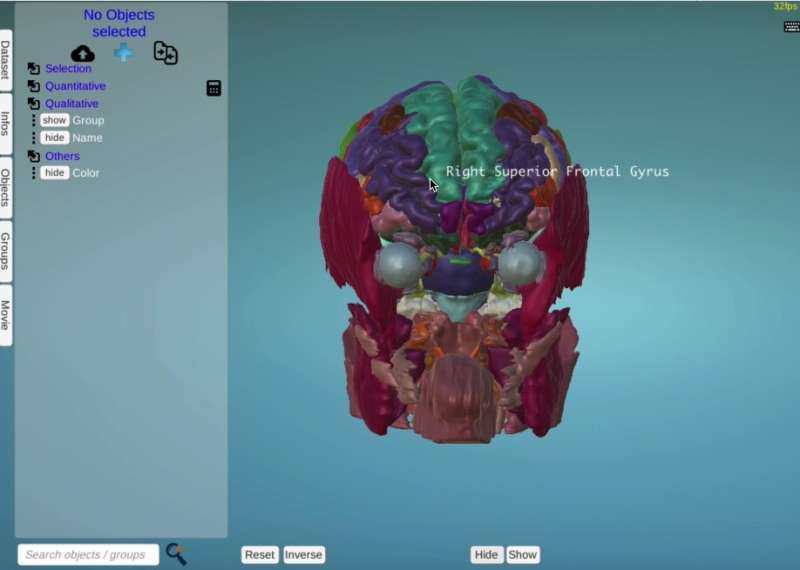July 10, 2019 feature
MorphoNet offers an interactive way to explore the bioimaging data revolution

Over the past two decades, research in morphology—the study of the shapes and structures of biological organisms—has exploded due to advances in imaging technologies. Researchers have generated massive amounts of visual data, such as by using CT scans to image the brain, cryogenic electron microscopy to visualize viruses and proteins at near-atomic resolution, and light-sheet microscopy to image internal organs, embryos, and various organisms.
In a new paper, a team of researchers from the universities of Montpellier, Lyon, and Toulouse I and III in France has collaborated to create MorphoNet.org, an open-sourced, publicly available, interactive, generic morphodynamic web browser to help researchers, teachers, and students to share, analyze, and visualize the abundance of new morphological data.
Part of the motivation for developing MorphoNet arose during the researchers' own work. Emmanuel Faure and his team at the University of Montpellier, CNRS, has been studying sea squirts (ascidians) and how their embryos develop during embryogenesis. In order to better understand the link between the organisms' phenotype and genotype, the researchers wanted to connect their shape evolution to the dynamics of their gene expression patterns. Using light-sheet microscopy, the researchers constructed several 4-D (3-D+t) datasets of developing embryos, and now they can use MorphoNet to further explore the gene-to-shape feedback using a link to the genetic database of ascidians.
MorphoNet has the potential for much more widespread use, and has several advantages over current morphological visualization platforms. For instance, existing platforms mostly focus on niche areas, and currently there is no tool that combines morphological data from all of the diverse subfields of biology in a single location. Also, most current platforms are in the form of software to be downloaded to a computer, rather than a web-based browser, making them difficult for users to maintain. Although a few web-based morphological databases exist, most do not allow users to upload new data, and their interactive capabilities are limited. The researchers developed MorphoNet to fill these gaps.
The researchers compare this era in morphological data to the genomic data revolution of the 1990s and early 2000s. At that time, the Human Genome Project and other genome sequencing projects were taking place, and researchers suddenly had access to an abundance of new data on DNA, chromosomes, nucleotides, and many other kinds of genetic material. To help facilitate the use of all this data, computational browsers were developed, such as the WashU Epigenome Browser and the UCSC Genome Browser. MorphoNet is intended to be analogous to these genomic browsers for morphological data.
MorphoNet runs on standard internet browsers and offers two types of access: unregistered users can access public datasets and have visualization rights only, whereas registered users have additional rights, such as the ability to upload and download data. As morphological data has many different formats, the researchers created a generic format so that any uploaded data is duplicated in this standard format, while the original copy also remains on the server. The standard format allows for the interdisciplinary networking structure, in which users can integrate data from multiple datasets and explore the results.
Some of the features of MorphoNet include the ability to group objects from different datasets to build higher-order structures, such as organs; group objects by their temporal ancestry, such as for tracking cell lineages; hide objects or make them partially transparent, allowing users to "see through" the anatomy of a human body or other organism; project new quantitative and qualitative data onto images as labels or heat maps; superimpose gene expression patterns onto images, thereby bridging genetic and morphological information; and calculate certain statistical properties of the quantitative aspects of morphological data.
One of the biggest challenges in creating a morphological browser was compressing the massive amount of data to allow its visualization and interaction. To do this, the images are compressed into surface meshes, which are rendered using the Unity3D gaming engine that runs on standard internet browsers. Also, while simple calculations can be performed directly on the server, more complex calculations can be performed externally by uploading any Python-based or ImageJ-performed calculations to the MorphoNet server.
In the future, the researchers plan to further use MorphoNet for their own research in developmental biology, as well as expand its features and explore the potential industrial applications.
"Priority will be given to working out new bugs, adding new datasets, and developing common user features," Faure told Phys.org. "As part of our long-term vision, we would like to better integrate all gene-expression dataset information with their corresponding cell shapes. A more technical axis that we are currently exploring (with the INRIA Hybrid Team) is to embed MorphoNet into a Virtual Reality Environment, to explore our 4-D datasets using a fully 3-D vision instead of a simple 2-D screen.
"On the side of potential industrial applications of MorphoNet, we think that industries could be interested in the use of MorphoNet for their own topics (architecture, aeronautics, etc.). We are currently working with the technology transfer accelerator platform Axlr in order to bridge our work to industry. In this direction, we also just asked for support from our local Region Occitanie."
For now, anyone interested in trying MorphoNet should contact Faure (email address can be found here).
"I can then open them an account and they will be able to start uploading their own data and enjoy the use of MorphoNet on their project," he said. "In any case, this is the first official release of MorphoNet so there are a few things here and there yet to fully develop and polish. I would be very happy to help any researchers interested in our tool."
More information: Bruno Leggio, Julien Laussu, Axel Carlier, Christophe Godin, Patrick Lemaire, and Emmanuel Faure. "MorphoNet: an interactive online morphological browser to explore complex multi-scale data." Nature Communications. DOI: 10.1038/s41467-019-10668-1
Links:
© 2019 Science X Network



















